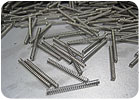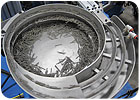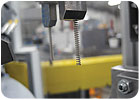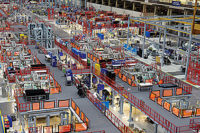
If you ever want to hear a manufacturing engineer swear, just mention the word “springs.” The coiled components come in a wide variety of sizes, and they’re used in many mass-produced products, ranging from pens and syringes to valves and lightbulbs. But, tiny springs often cause big headaches when it comes to automated assembly.
Many engineers have horror stories about the pesky parts. “They’ve been a nightmare forever,” says Carl Nelson, president of Performance Feeders Inc. “Springs can easily get you in a lot of trouble. There are many variables with spring designs, and each application is different.”
Springs are often a very inexpensive component in an assembly. However, the problems created in detangling and handling them can greatly affect the productivity and efficiency of automated assembly systems.
“Springs are inherently difficult to handle for a variety of reasons,” explains Jeffrey Given, president of Comtech North America. “When handled in bulk, they have a tendency to get tangled together. This problem is magnified if the spring has open-end coils, which can result in the springs being corkscrewed into one another.
“Springs are different from most other components,” says Given. “They tangle, bounce and, depending on the design of the spring, need to be fed and oriented in a variety of positions.
“In an automated application, springs are loaded into a feeding system in bulk and many times must be separated before they are oriented and fed to the next step in the assembly,” adds Given. “If not careful, springs can be damaged by an operator trying to separate them during [a semiautomated] assembly.”
Tangled springs present the biggest challenge. If a spring can be separated, it can usually be fed in some way.
“One of the problems we face when feeding springs from bulk is keeping them separated when they are being queued up and escaped,” Given points out. “If the spring has closed ends, this normally isn’t an issue, but if there are open ends or if the spring is a conical or torsion spring, we will look for other ways to handle the springs.
“As customers are requiring higher feed rates in their assembly processes, we [are forced] to develop ways to not only wind the spring faster, but deliver the springs to the point of assembly more quickly,” says Given. “This is compounded when the springs also require testing of any kind.”
Bob Rice, team leader for applications engineering at Automation Tool Co. (ATC), says springs are a challenge for four basic reasons:
- They absorb energy, so vibratory feeding can be difficult.
- They intertwine and tangle in little balls.
- They can be difficult to grab because they collapse easily.
- They are not predictable.
Springs are also difficult to work with because they are often small and easily damaged. They are typically bowl-fed, which can cause the springs to become tangled. This problem is usually common with springs that are tightly wound and contain open ends.

Numerous Sizes and Shapes
Size can also present a challenge if the outer diameter is close to the same size as the free length. When the outer diameter and free length are a similar size, springs can easily lose orientation in the escapement, causing the part to get jammed and the assembly machine to shut down.“There are so many varieties in shape, size and material commercially available, that it’s sometimes difficult to select the ‘right’ handling device out of the gate,” says Peter Heinz, applications engineer at Sortimat Technology. “The goal is to singulate springs for manual or automated handling. If this can’t be guaranteed, we have to get creative.
“If it is not a mature product, we usually have the option to suggest design changes to the spring,” adds Heinz. “Tolerances on springs are usually a bit larger and [require] a more generous approach when fed, like straightness, length, outer diameter and cleanliness.
“How the springs will be presented is key,” Heinz points out. “Usually, springs are supplied in bulk and placed in bags with random orientation. [Whenever possible, it is] nice to have springs provided in trays or any other way for individual pick-up. We’ve seen this done more in Europe.”
There are many types of feeding systems available for handling springs in bulk, depending upon the spring design, the difficulty in separating them, and the feed rates that are required. “If a fully automated system is required or if a particular spring is too difficult to separate and feed, in-line spring coiling is a great option and many times the best solution,” notes Given. “In-line spring coiling eliminates any tangling issues, as the springs can be coiled, cut and fed on demand, one spring at a time, to an operator or directly to the point of assembly.”
In addition, springs can be heat-treated, using a resistive heating method, and tested for the load, length and diameter of each spring, all as an in-line process. According to Given, this helps ensure that only “good” springs (springs within the required tolerances) are delivered to the final assembly. Any springs outside of the required tolerances are rejected prior to assembly.
A common problem when feeding springs through a tube in an automated assembly process, especially at higher feed rates, is the tendency for the springs to bounce when they are loaded into a nest or onto a mandrel of some kind. This pesky problem can usually be resolved by regulating the amount of air being used to transport the springs.
“Pens and syringes are perfect examples, because the volumes are ultra high,” explains Bill Bodine, partner at HB Automation LLC. “Any high-speed requirement, such as continuous motion or high-volume indexing assembly, will push the envelope for spring feed rates and magnify the difficulties exponentially.
“These are often springs that are delicate, floppy and feature wide-open coils,” adds Bodine. “Tiny tension springs used in micro switches are extremely difficult, because of where they go in the assembly and how the ends need to be attached to tiny features, all done in tension.”

Types of Springs
However, because of the wide variation of characteristics such as outside diameter, inside diameter, free length, wire diameter, diameter-to-length ratio and manufacturing tolerances, determining which spring is the most difficult to handle with automation is near impossible. Rather, each spring type has its own set of challenges.
“Torsion springs are more likely to tangle,” says Michael Limb, president of Spring Design Consultants. “Also, springs with tapered bodies do not settle in identical positions and are therefore difficult to feed.”
“Torsion springs often have external arms that create problems,” adds ATC’s Rice. “But, any open-end spring that allows them to thread together [can cause problems]. Tapered springs [are also challenging], because they nest in one another easily.”
“Poorly designed springs are the worst,” claims Nate Sornborger, engineering manager at Arthur G. Russell Co. “When product designers don’t know about design for manufacturing and assembly, they often [specify] springs with only the final function in mind and skip over the steps required to get it there. Some examples are compression springs with open ends, [which have] no groups of tight coils to prevent nesting; extension springs with incomplete loops on the ends so they hook together; and torsion springs with funny jogs in the legs.”
Automated assembly typically means bulk feeding, which can cause problems when springs are involved. Unfortunately, vibratory feeders struggle when there is tangling.
“Depending on the type of spring, whether it be compression, coil, tension, leaf, conical or z-fold, there are certain features to watch out for,” warns Bodine. “For example, a coiled compression spring, perhaps the most common, will tangle if the wire diameter is less than the coil thickness or if the ends are not closed to a greater dimension than the coil gap. Conical springs will screw into each other.
“But, other than feedability, the main difficulty with springs in automation is often the delicate nature of some small springs,” Bodine points out. “Often, springs can be fabricated on-line. [However, they often] require annealing, which just adds to the complication of that solution. All in all, I’d say wide open coil springs cause the most headaches, but it really comes down to feeding, singulating and orienting without damage.”
According to Given, cylindrical compression springs seem to be the easiest springs to handle and feed, but sometimes the most difficult to separate. He says torsion springs typically pose the biggest challenge to feed.
“We have several methods for separating torsion springs and feeding them one at a time to a single point of assembly or to multiple locations,” notes Given. “As every spring design is different, so are the requirements for feeding springs.
“Some torsion springs with smaller legs can even be delivered in a tube,” adds Given. “Springs can also be handled with a gripper system or device, fed down a guide wire or via a vibration track. If the free length and the outer diameter of the spring are close in size, the springs have the ability to tumble in a tube, which can affect the orientation of the spring as it is delivered. Another method must then be used to handle these springs.” A
Learn more about springs by clicking www.assemblymag.com and searching for these articles:
- Types of Springs
- With Springs, Size Matters


